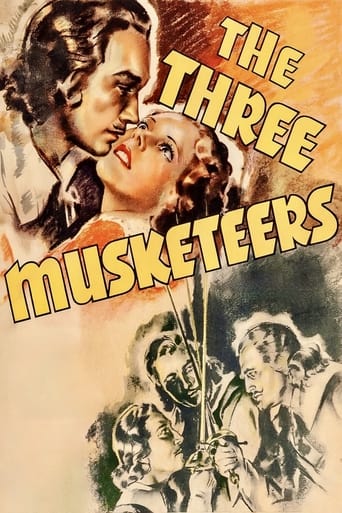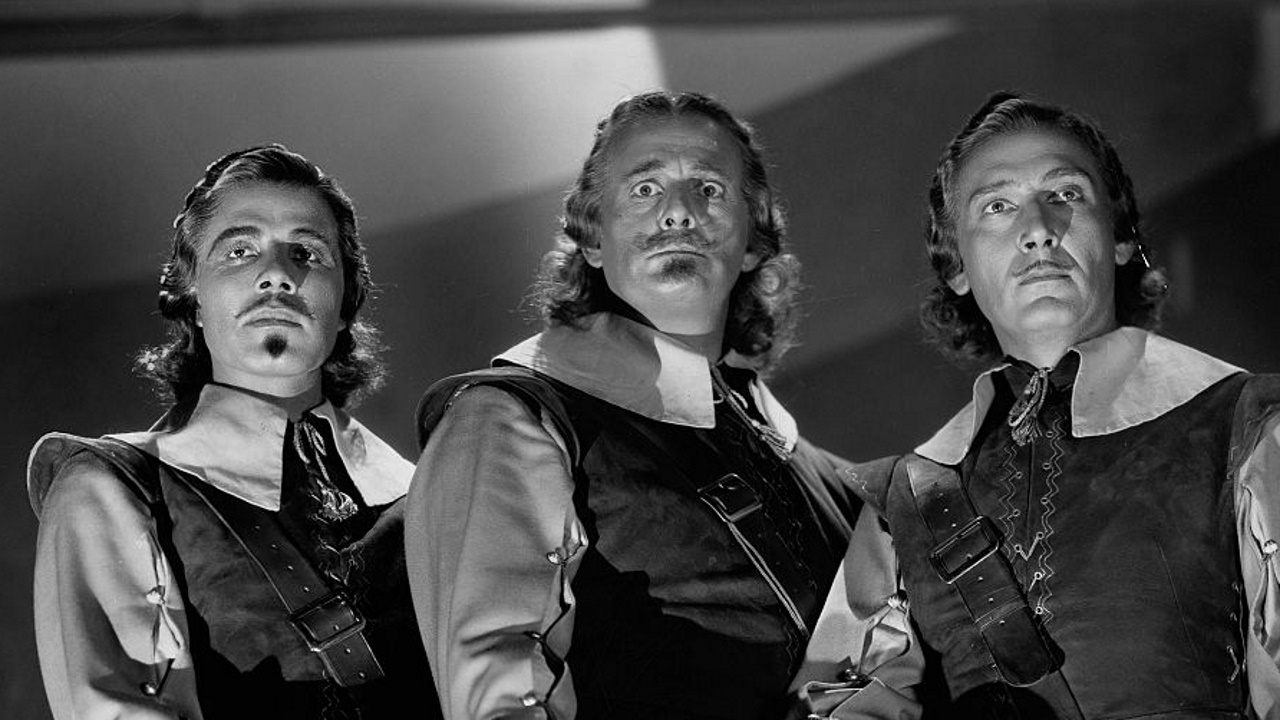utgard14
Cocky young swordsman D'Artagnan (Walter Abel) arrives in Paris and is taken under the wing of three musketeers (Paul Lukas, Moroni Olsen, Onslow Stevens). First English-language film version of the Alexandre Dumas story. It's pretty dull stuff. Walter Abel is painfully miscast. This was his first starring role. He would have better luck in his career as a character player. Film debut of Moroni Olsen. Three Musketeers movies should be fun, exciting, and action-packed. This one's tedious. Even the action is unexciting. Max Steiner wrote the music and lyrics for the corny theme song. Hardly his best work. Watchable but forgettable.
MARIO GAUCI
This is at least the seventh official adaptation I have watched of the archetypal Alexandre Dumas swashbuckler – the others dating from 1921 (Silent), 1939 (semi-musical), 1948 (for my money, the definitive version), 1953 (French), 1963 (Italian spoof) and 1973/1974 (the popular star-studded two-parter); there are still a few more to go, to be sure – including a renowned French Silent serial and a vintage British TV mini-series which I will be getting to shortly – not counting myriad sequels, offshoots and variations! Being the first Talkie rendition and emanating from the golden age of the genre, much was perhaps expected of the outcome – especially since its director had just supplied the best-regarded take on another of the author's classic and oft-filmed adventure tales, namely THE COUNT OF MONTE CRISTO (1934); however, it ended up proving so uninspired that the picture has virtually fallen through the cracks over the years – until the recent dusting off, being an RKO production, via Warners' "Archive Collection"! While the essence of the narrative is there for the most part, the spirit is sadly lacking (despite a script co-written by Lee and the renowned Dudley Nichols); not surprisingly, it looks fairly good – but the cast is variable to say the least! The worst offenders here are certainly Walter Abel's bland D'Artagnan (he is awkwardly speechless during the opening sequence!) and Paul Lukas' unimposing Athos (with his trademark broken English delivery intact!); the remaining Musketeers are played by Moroni Olsen (a typically rowdy Porthos in his debut) and a young Onslow Stevens (an adequately brooding Aramis) – incidentally, their famous exploits have even yielded a theme tune! The other famous characters are just as unevenly served – with Ian Keith's Count de Rochefort (for the record, he would reprise the role in 1948) and Margot Grahame's Milady de Winter (who bows out not in the traditional manner, i.e. at the mercy of the public executioner, but rather by leaping off a bridge into the river below!) acquitting themselves reasonably well, while Miles Mander as the King and Nigel de Brulier's Cardinal Richelieu (a part he would tackle four times in all, including the 1921 original and two separate versions, made in 1929 and 1939, of Dumas' "The Man In The Iron Mask") barely register here! That said, the fencing by Fred Cavens (a master in his art throughout the genre's heyday) delivers the expected goods...but, as a general rule, the positives are outweighed by the negatives – perhaps never more so than when D'Artagnan engages in drunken singing (with his just-met beloved Constance on one arm and the Queen of France{!} on the other being urged to helpfully join in) to escape the attention of the Cardinal's men after a clandestine night-time rendezvous with the Duke of Buckingham!!
bkoganbing
The Three Musketeers was probably RKO Studio's biggest budget item for 1935. It's a condensed version of the classic novel by Alexandre Dumas and casts Walter Abel in the lead role of D'Artagnan.Walter Abel had a distinguished career as a fine character actor, but from this film he just not have the charisma needed to carry a whole film. Ironic that the three most obvious D'Artagnans all were not available in 1935. Douglas Fairbanks, Jr. was in Great Britain, Tyrone Power was a year away from his break out picture, Lloyd's of London and Errol Flynn was just being introduced at Warner Brothers in Captain Blood. Why none of those three ever got to play D'Artagnan is a mystery, especially Flynn who did do a version of The Three Musketeers as a radio play.The best bit of acting is from Ian Keith as DeRochefort. The novel has DeRochefort as Cardinal Richelieu's chief enforcer, but here he's a loose cannon with very much his own agenda. Paul Lukas makes a brooding Athos although the best portrayal of that role comes from Van Heflin in MGM's version in 1948.This is a decent version of the classic and far superior to what Darryl Zanuck inflicted on the public in 1939 with the Ritz Brothers as Athos, Porthos, and Aramis.
Ron Oliver
In 1625 an ambitious youth joins forces with THE THREE MUSKETEERS to save the French Queen's honor from the machinations of the cruel Cardinal Richelieu.RKO does Dumas proud in this rousing version of the ancient swashbuckler. Too long ignored or slighted as dull or drab, it is in fact lavish & lively, with dashes of welcomed humor, and should keep the interest of most uncritical viewers. The absence of any major stars is actually a benefit, as the plot is able to speak for itself without being sifted through the skein of celebrity.Initially, Walter Abel seems a curious choice for the impulsive D'Artagnan, but his exuberance & enthusiasm quickly envelop the role. Paul Lukas, Moroni Olsen & Onslow Stevens have fun as the title characters and the fact that there's very little reason to tell them apart does not detract from the overall enjoyment of the film.One could wish for a bit more screen time for Ian Keith & Nigel de Brulier as the villains de Rochefort & Richelieu respectively, but Margot Grahame makes the most of her opportunities as the evil Milady de Winter.Heather Angel provides the romantic stimulus for Mr. Abel, while Lumsden Hare as the Musketeer Captain & mild-mannered John Qualen as D'Artagnan's servant equip themselves well in small roles. Movie mavens will recognize an uncredited Lionel Belmore as an innkeeper.In his single scene as the Duke of Buckingham, British actor Ralph Forbes reveals the talent which, in a fairer world, would have made him a major Hollywood star.Not surprisingly, the original story has been streamlined & altered in various ways and at least a couple of notable deaths have been omitted, so as to provide a happier fadeout.*****************************************What were the facts surrounding the historical Richelieu & Buckingham? Since the novel & films make much of their rivalry, a closer examination is in order.Both men rose from semi-obscurity to positions of enormous power & influence in their respective kingdoms. Each found it necessary to dominate the weak sovereigns whose patronage they enjoyed. Both endured the utter contempt & hatred of powerful domestic factions allied against them. And were there ever a flirtation between the French Queen Anne of Austria and Buckingham, it was of a very mild nature. There certainly was nothing resembling The Adventure of the Queen's Diamonds and all the derring-do associated with it.Armand-Jean du Plessis, Cardinal and Duke de Richelieu (1585-1642), came from a minor gentry family which was saddled with enormous financial debt upon the death of his father. However, blessed with a very good brain & a manipulative mother, Richelieu used his intellectual charm to advance his ascent through the Byzantine levels of Church hierarchy. Once having caught the attention of Louis XIII Richelieu never looked back. Eventually wielding absolute authority, the Red Eminence took as his life's mission to thwart Spanish Habsburg hegemony in Europe and to crush all outbreaks of French Protestantism as they arose throughout the kingdom.For his part, George Villiers, 1st Duke of Buckingham (1592-1628), had his extreme physical attractiveness to thank for grabbing the eye of James I - who liked to dance both ends of the ballroom - and later became the favourite of Charles I as well. The son of a knight, Buckingham soon rose to an eminence of power and angered the nobles by his monopoly of the king's affections and his arrogant accruement of great wealth. As a diplomat & military strategist, Buckingham was hopelessly inept and he needed the king's protection to save him from trial in the Star Chamber. Having failed disastrously in an attempt to succor the Huguenot of La Rochelle, France, he returned to England where he was quickly assassinated by a disgruntled naval officer. When news of Buckingham's death reached London the people rejoiced in the streets.


 AD
AD


